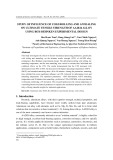
* Corresponding author.
E-mail addresses: honghs501@yahoo.com (H.-S. Hong)
© 2019 Growing Science Ltd. All rights reserved.
doi: 10.5267/j.esm.2018.10.002
Engineering Solid Mechanics 7 (2019) 71-82
Contents lists available at GrowingScience
Engineering Solid Mechanics
homepage: www.GrowingScience.com/esm
A method for determination of equivalent limit load surface of fiber-reinforced nonlinear
composites
Jun-Hyok Ria and Hyon-Sik Honga*
aInstitute of Mechanics, State Academy of Sciences, Pyongyang, DPR of Korea
A R T I C L EI N F O A B S T R A C T
Article history:
Received 10 July, 2018
Accepted 8 October 2018
Available online
14 October 2018
In this paper, a method for determining the limit load surface of fiber-reinforced nonlinear
composites such as elasto-plastic composite is proposed. Using the stress approach of the
homogeneous theory and the linear matching method (LMM), the limit load surface of the fiber-
reinforced composite is numerically evaluated in the π- plane, and at the same time, two limit
analyses determine the approximate Hill's anisotropic yield criterion for the limit load surface of
the fiber-reinforced composite. The Hill's yield criterion determined by 2 limit analyses becomes
the inscribed ellipse of the limit load surface evaluated numerically in the π- plane, and the limit
load surface can be evaluated more accurately by the two tangent lines perpendicular to the minor
axis of the inscribed ellipse and the circumscribed circle of the inscribed ellipse. This means that
the limit load surface of fiber-reinforced nonlinear composite can be completely determined by
only 2 limit analyses. In addition, it is found that the limit load surface is related to the equivalent
strength surface of composite, and that it satisfies the Reuss and Voigt bounds.
© 2019 Growing Science Ltd. All rights reserved.
Keywords:
Nonlinear homogenization
RVE
LMM
Limit analysis
Macroscopic yield surface
1. Introduction
It is well known that composites are extremely flexible in their application and are now increasingly
used in the aerospace, automotive, and other fields since the material properties required by the designer
can be easily achieved by optimizing the geometric arrangement and content of the phases constituting
them (Qin & Yang, 2008). The macroscopic arrangement of the phases is considered to be statistically
homogeneous. The minimum unit of this macroscopic arrangement, which can reflect the macroscopic
properties of the material, is called the representative volume element (RVE). The concept of RVE
created a new era for the development of composite mechanics. The macroscopic properties of
heterogeneous materials can be determined by the analysis at the RVE level, and the multi-phase
composite material can be regarded as the homogeneous material with macroscopic properties from the
statistical homogeneity. From this, studies have been focused on the research of the problem of how
the microscopic properties such as the geometric arrangement, the content and the material property of
the phases constituting the composite material are related to the macroscopic properties. This problem
was answered by the homogenization theory (Qin & Yang, 2008; Galvanetto & Aliabadi, 2010). Fig.
1 gives the schematic description of homogenization theory.

72
Fig. 1. Procedure for homogenization of heterogeneous material
So far, the homogenization theory of linear elastic composites has been almost completely
established, but many problems remain open in the homogenization of nonlinear composites. Lastly,
most of the previous studies on the homogenization of nonlinear composite material have been devoted
to the evaluation of the constitutive relation of nonlinear composite material.
Secant, tangent, and generalized secant methods have been proposed to obtain the variation limits
of the equivalent potential by using appropriately selected linear comparative composites (Castañeda,
1991; 1996; 2002a;b). Castañeda (1991) proposed a variational method of using linear comparison
composite that was chosen optimally, and Castañeda (1996) developed the more generalized method
of using the linear comparison composite by combining the tangent moduli of phases. Castañeda
(2002a,b) improved the variational method by using higher-order homogenization methods. However,
it is very difficult to obtain the analytical equivalent potential except for special cases (Michel &
Suquet, 2003). Thus, numerical methods have been proposed to obtain the equivalent constitutive
relation of composite materials including Transformation Field Analysis (TFA) and Non-uniform
Transformation Field Analysis (NTFA). Michel et al. (1999), Moulinec & Suquet (1998) and Moulinec
& Suquet (2003) presented a numerical method for evaluating the local and global behavior of
composite materials with linear and nonlinear phases using finite element method and Fast Fourier
Transforms (FFT). Michel & Suquet (2003), Michel & Suquet (2004), Lahellec & Suquet (2007) and
Fritzen & Böhlke (2010) extended TFA into NTFA in consideration of non-uniform inherent strain,
proposed methods for numerical implementation, and applied it to elasto-plastic composites.
Although the constitutive relation between macroscopic stress and strain of the composite material
could be determined by the equivalent strain potential evaluated according to the constitutive relation
and geometric arrangement of the every phase, the macroscopic strength criterion will not be
determined. In practice, a detailed constitutive relation between macroscopic stress and strain is
important, but macroscopic strength criterion is also of equal significance. Even though some
researchers evaluated the equivalent strength surface expressed by the macroscopic stress or the strain
from the limit and shakedown analysis of RVE for the elasto-plastic composites and studied the optimal
design of composites based on it, their studies was restricted to the two-dimensional problem, and could
not evaluate the equivalent strength surface with the low computational cost (Chen et al., 2010, 2013;
Chen & Hachemi, 2014). In more detail, they numerically evaluated the equivalent limit load surface
of transversely isotropic composites by two-dimensional RVE analysis, and determined the Hill's
anisotropic yielding criterion by the numerical fitting based on it. Nevertheless, the macroscopic stress
states cannot be placed on one π-plane with constant hydrostatic pressure since their method cannot
adjust triaxial stress in the two-dimensional problem. This not only makes it impossible to reasonably
select a numerical fitting point, but also to obtain the intuitive shape of limit load surface by the
numerical method.

J.-H. Ri and H.-S. Hong / Engineering Solid Mechanics 7 (2019)
73
In this paper, the limit analysis of 3D RVE is carried out in order to study the case where the
macroscopic stress state is placed on a π-plane with constant hydrostatic pressure. Computational
points are taken on the π-plane with constant hydrostatic pressure and the corresponding macroscopic
stress state is determined. Then, the limit load surface is determined numerically by calculating limit
loads of fiber-reinforced composite material in the macroscopic stress states, and at the same time, an
approximate Hill's anisotropic yield criterion is evaluated by two limit analyses. The Hill's anisotropic
yield criterion determined from two limit analyses becomes an inscribed ellipse of the limit load surface
obtained numerically, and two tangential lines perpendicular to the minor axis of inscribed ellipse and
the circumscribed circle of inscribed ellipse result in more accurate evaluation of the limit load surface.
Thus, the limit load surface of fiber-reinforced nonlinear composite could be completely determined
by only two limit analyses. It is also shown that the limit load surface is related to the equivalent strength
surface of composite material, and that the equivalent strength surface satisfies the Reuss and Voigt
bounds. Every phase is assumed to be the perfectly-plastic material with the von Mises yield criterion.
Stress approach is used for the homogenization boundary condition, and the Linear Matching Method
is adopted for the limit analysis.
The contents of this paper are as follows. Section 2 briefly formulates the Melan's theorem and
section 3 describes the algorithm of LMM. Section 4 is devoted to the explanation of the
homogenization theory and the Hill's anisotropic yield criterion. The stress approach method for
determining the limit load of composite material is described and the characteristics of Hill's anisotropic
yield criterion is presented, and the coordinate transformation relation that conforms the yield surface
onto the π-plane is derived. Some numerical results for the fiber-reinforced composite are presented in
section 5. The limit load surface of fiber-reinforced composite is extracted by comparing the
numerically determined limit load curves and the approximate Hill's anisotropic yield criterion for
fibers with different yield stress. A few concluding remarks are mentioned in section 6.
2. Lower and upper bound theorem of limit analysis
Let us consider the limit analysis of perfectly-plastic material which follows von Mises yielding
rule. It is assumed that a body occupies volume V with surface S where a traction is given as zero or
on and displacement 0 is specified on (
). Here, P is a scalar parameter
defining relative magnitude of applied load as compared with a reference load . The lower and upper
bound theorem of limit load can be postulated as follows, respectively (Chen & Hachemi, 2014; Ponter
& Carter, 1997; Ponter et al., 2000).
Lower bound theorem:
If, for the external load
, there exists a statically possible stress field *
ij
such that
yij
f
* (1)
At every point within V, then LBL PP . Here, f is a von Mises yield function and y
is a uniaxial
yield stress. Thus, one can know that a maximum value of LB
P becomes lower bound of limit load.
Upper bound theorem:
If, for the external load UB
PP , there exists a kinetically possible displacement rate field *
i
u
and
its corresponding strain rate field *
ij
such that
dVupP ij
SV
p
ijiiUB
T
***
, (2)

74
where *p
ij
is a stress point at yield associated with *
ij
, then satisfies UBL PP
. Hence, one can know
that a minimum value of UB
P becomes upper bound of limit load.
3. Linear matching method (LMM)
The LMM is based on the linear elastic finite element analysis (FEA) with spatially varying material
properties (Ponter & Carter, 1997; Fuschi & Engelhardt, 2000; Chen & Ponter, 2001). LMM has been
successfully applied to the limit and shakedown analysis of structures subjected to heating and inner
pressure and composites. Chen (2010a,b), and Cho & Chen (2018) presented the numerical value
implementation of LMM by using ABAQUS user subroutine UMAT, and applied the LMM to the
shakedown analysis of structure subjected to the cyclic heating and mechanical load. Pisano & Fuschi
(2007), Pisano & Fuschi (2011) and Pisano et al. (2013) evaluated the strength of fiber-reinforced
laminates by formulating and implementing the LMM for orthotropic composites. For the LMM, the
Young’s modulus is changed spatially such that stress field corresponding to a certain kinetically
possible strain field is placed on the yielding surface at every point of material. The Poisson ratio is
taken as 0.4999999 since material is considered to have plastic incompressibility. LMM algorithm
could be formulated as follows (Ponter & Carter, 1997; Ponter et al., 2000; Chen & Ponter, 2001).
- Initialization: Set 1
0
UB
P,
EE x
1.
- kth iteration:
The linear elastic analysis with the Young’s modulus of
x
k
E is performed under a load pPk
UB
1
and k
ij
, k
ij
and k
i
u is obtained, respectively.
Lower and upper bound of the limit load at kth iteration is evaluated as
k
ijeq
y
k
UB
k
LB PP
1
, (3)
T
S
k
ii
k
UB
V
k
ijeqy
k
UB
k
UB upP
PP 1
1
,
(4)
where, eq
and eq
denotes equivalent stress and equivalent strain, respectively.
1k
E
at 1kth iteration is updated as follows.
1
k
ijeq
y
k
E
. (5)
Eq. (5) gives 1k
E at 1kth iteration such that stress field corresponding to strain field k
ij
obtained
at kth iteration lies on the yielding surface. Nevertheless, for high gradient of stress, Young’s modulus
evaluated by Eq. (5) may not give stable solution, sometimes. In order to overcome this numerical
difficulty without any affection on LMM solution, we do the normalization using initial Young’s
modulus ref
E of material.
We denote a minimum value of Young’s modulus
x
k
E on whole region obtained at 1kth iteration
by
x
x
kk EE min
min . Then, after performing kth iteration, 1k
E at 1
kth iteration will be evaluated
by

J.-H. Ri and H.-S. Hong / Engineering Solid Mechanics 7 (2019)
75
min
1
k
ijeq
y
k
ref
k
E
E
E
, (6)
instead of using Eq. (5). Even though Eq. (6) shows a theoretical equivalence with Eq. (5), our
computational experiences ensure that Eq. (6) can improve the numerical stability much more as
compared with Eq. (5) (Ri & Hong, 2017).
The LMM gives a set of non-increasing upper bounds of the limit load, but occasionally it may not
give a set of non-decreasing lower bounds for the lower bound. There is a method to use the following
Eq. (7), instead of using Eq. (5), which is called an Elastic Compensation Method (ECM) (Pisano &
Fuschi, 2011; Pisano & Fuschi, 2013; Ri & Hong, 2017).
y
k
ij
k
ijeq
y
y
k
ij
k
E
E
eq
eq
1
(7)
Although the ECM gives both a set of non-increasing upper bounds and a set of non-decreasing
lower bounds, the convergence rate of upper bound set cannot be faster than the LMM. In fact, the
ECM was developed earlier than the LMM, but now it is used as a complementary method to the LMM
that is perfect theoretically. Moreover, since LMM and ECM differ only in whether the Young's
modulus is changed by Eq. (6) or Eq. (7) in the iteration process, the upper bound of limit load is
evaluated by the LMM and the lower bound by the ECM, without a special distinction of both methods
in this paper. The limit analysis is performed using the UserMat subroutine of the commercial software
ANSYS.
4. Homogenization theory and anisotropic yield condition
The mechanical behavior of composite materials could be considered on two scales, macroscopic
one
x
and microscopic one y. Macroscopic scale and microscopic one have the following relation (Qin
& Yang, 2008; Galvanetto & Aliabadi, 2010).
xy . (8)
Here,
is a material parameter reflecting the size of RVE. The stress and strain on the macroscopic
scale are defined as the volume average of microscopic stress and strain on RVE, respectively. Namely,
R
ijij
R
ij dV
V
1, (9)
ijij
R
ij
R
dV
V
1, (10)
where R
V is the volume of RVE.












![Bài tập tối ưu trong gia công cắt gọt [kèm lời giải chi tiết]](https://cdn.tailieu.vn/images/document/thumbnail/2025/20251129/dinhd8055/135x160/26351764558606.jpg)













